Diverse and motivating "English online"
Starting to learn a language, we encounter many difficulties and questions: there is not always enough time to go to the teacher, we quickly lose interest or begin to experience stagnation in learning. We tried to find a solution to all these problems and turned it into an online platform that will immerse you in the language environment and ultimately allow you to be proud of your achievements.
EnglishDom teachers analyzed online courses on the market and found two main approaches to learning: an interactive textbook or cramming. Since both options do not imply diversity, then, accordingly, the results will be far from expected. Therefore, we tried to create a completely new product for the market and simulate a full-fledged lesson during which a student will be able to get all the necessary knowledge and consolidate the acquired skills without a teacher.
This is the first “release" of the product of our school. In the future, we plan to refine and improve the course, come up with new training opportunities and select materials of different levels. So now we need an honest feedback about the course, content, design and gamification. We ask you to register, test your knowledge and learn English thanks to our course. And after completing the course, send us your feedback on all stages.
We give you one-year access to the Online Course English course. To gain access, simply follow the link and after applying the promotional code, go through the registration by clicking on the link .
So that you can quickly understand the structure of the proposed course, we offer you a small instruction that will allow you to engage in training more effectively.
In developing our course, we first of all tried to solve the main problem of online services - a quick loss of interest in learning and, as a result, a decrease in student motivation (according to our surveys of online school students, after 3-4 months, the student quits classes).
Briefly about the course:
● the system provides the following difficulty levels: English for beginners (Elementary), conversational (Pre-Intermediate), intermediate level (Intermediate) + Upper-Intermediate (above average).
● Each level consists of 25 lessons: 25 topics in grammar + topics in vocabulary in conjunction with subsequent complication;
● The basic principle is structure, practice and consolidation. The student assimilates the material in different contexts, repeating it several times, eventually bringing the acquired skills to automatism. As practice shows, it is this approach that allows you to achieve better results, while not worse than in class with a real teacher.
We begin the dive! You are already waiting for the first lesson with a list of tasks.

Dictionary
Let's look at a dictionary that offers a list of thematic words for study.
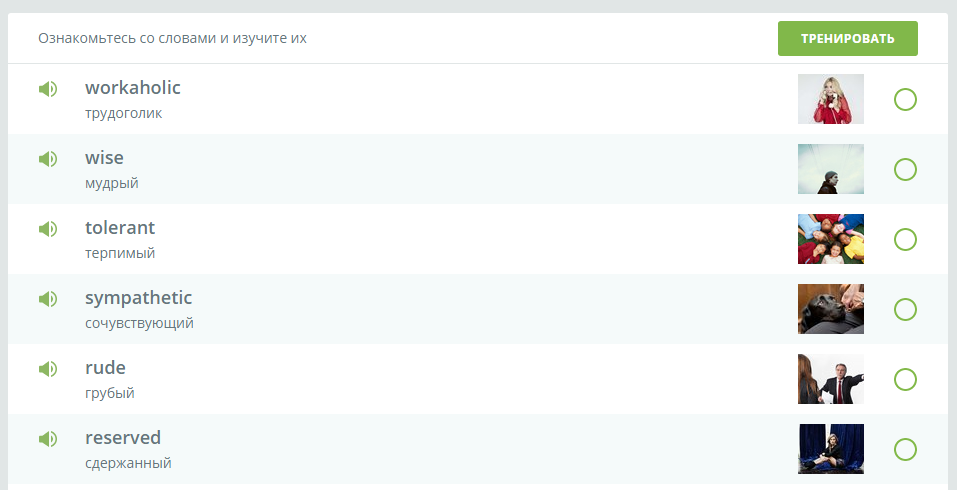
The content is selected in such a way that the words given at the beginning of the lesson are repeated throughout the lesson and used later in other topics. Each word is accompanied by translation, transcription and image - all this helps to highlight the speech structure in memory, linking it with the desired association.
The “Train” button opens a page with a new task: you need to spell a word, select or enter the correct translation. Each correct answer increases the level of progress, while the learned words will not disappear: you will repeat them in the next steps, and so on until you are fully included in the active vocabulary.
Theory
Theory is a grammatical part that allows you to understand the database and fill in the existing gaps. The concept of the material is strictly structured and dosed, and the flow is maximally simplified and accessible so as not to get confused in unnecessary terminology. This allows the student, not overloaded with information, to gain real knowledge, and not a headache.
During each lesson, students must learn a small and understandable rule. The text is accompanied by examples and supplemented by a video explaining the real teacher.
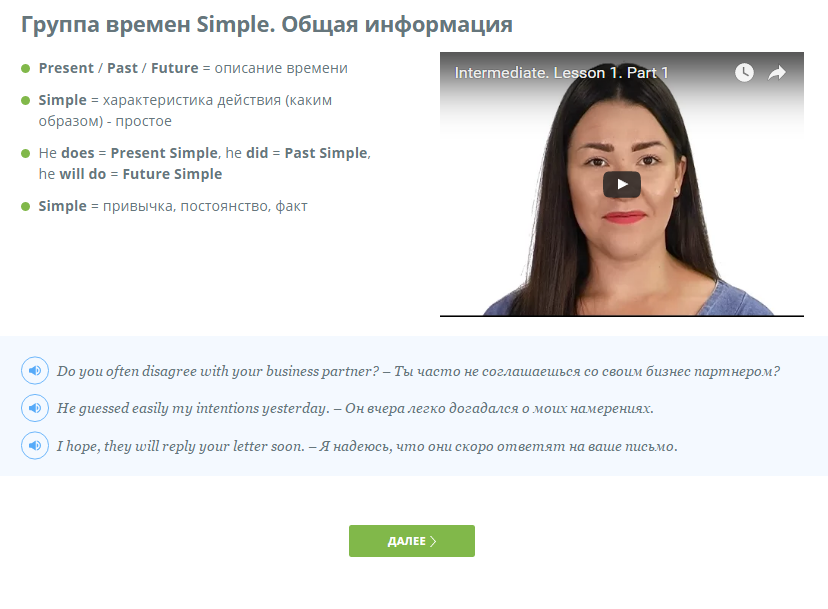
Practice
After the theory we pass to Practice! Grammar and vocabulary exercises from the lesson. There are three types - enter the missing words, choose the correct option and translate the sentence using special blanks. These types of tasks help to memorize grammar, as well as repeat written speech and make better use of individual meanings of words. All exercises are supplemented by audio tracks so that you hear the correct pronunciation of words and memorize them.
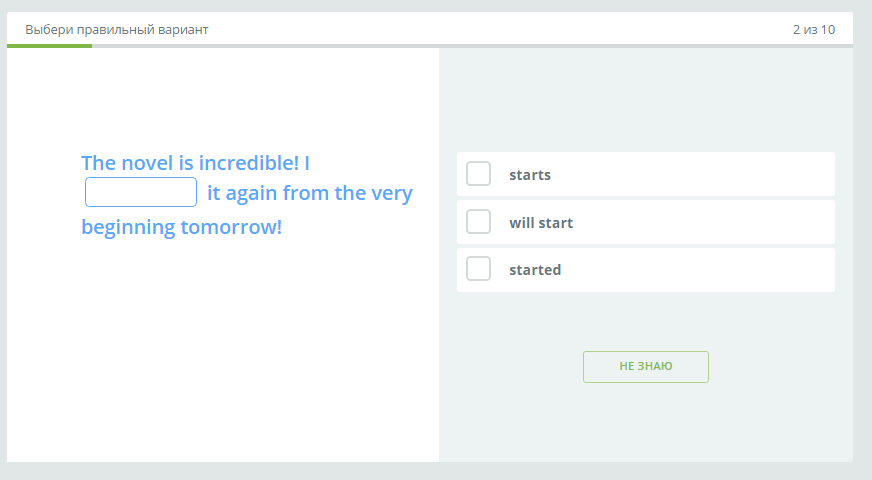
After passing, you will see your results in the form of progress, having received experience points, and proposals in which mistakes were made can be re-executed.
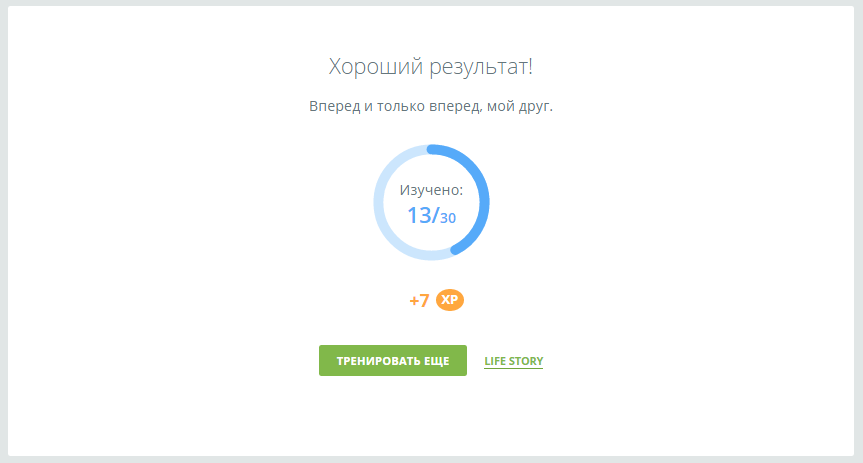
Life-story
One of the ways to replace the routine work with text is the Life story section. We tried to simulate up to five different workouts, allowing you to immerse yourself in the maximum language environment, and not boredom. All material is taken from various sources - popular films and series, interesting books, modern songs - and touches on a variety of life situations from simple and ordinary to the most incredible and distant from the usual “London is the capital of Great Britain”.
Teachers carefully worked out the content, highlighting grammatical constructions and phrases for memorizing, which are learned in exercises after the text. The list of tasks is quite varied - to fill in the blanks, put the events in the correct sequence or guess how truthfully in relation to the video or text several suggestions are made. As a result, all the material is interesting to read and easy to remember. No boring textbooks!
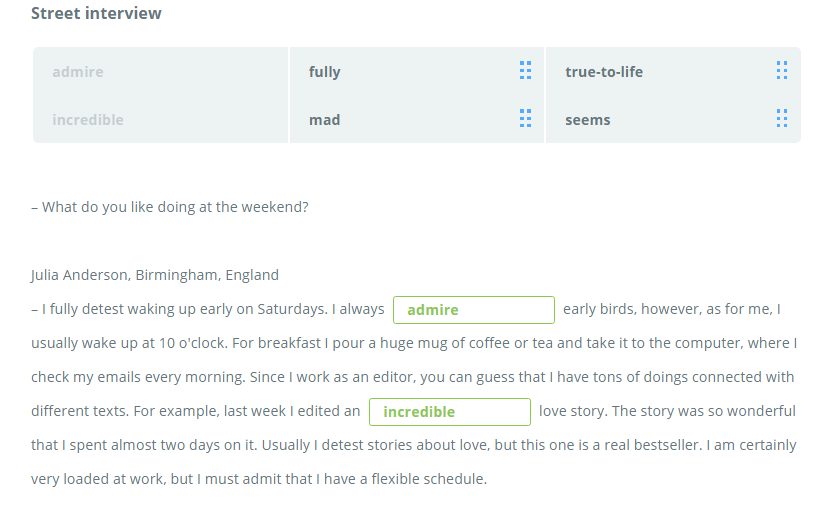
Phrasebook
To memorize phrases and sentences effectively, you will need a special tool - Phrasebook. Any skill needs to be fixed with persistent training. To ensure that students are not bored of repeating speech constructions, we use elements of the game during the lesson, which allows students to practice various exercises on their own. Our experience with students shows that sustainable knowledge and the ability to put into practice a particular rule comes after 7-9 repetitions. And if these exercises are as diverse as possible, this will help not to lose interest in learning.
To ensure that the speech is correct and figuratively rich, students are encouraged to practice pronunciation of popular idioms, as well as standard questions and answers to them. And all this is fixed with the help of exercises on choosing an option, filling in the gaps or translating in parts.

Dialogue
Dialogue is associated with the development of a conversational skill. Since the course was written by current teachers, it contains their best case studies on "live" lessons. We took the most real and useful situations, as well as the dialogs that students liked, and beat them. Students are invited to participate in the survey (interviewer is a robot), however with existing answers (they are generated as part of the topics being studied). You need to pronounce them correctly into the microphone or (if it is not) manually select the correct answer.

Conversation lesson
If you want to make sure in practice that the classes were not in vain and the material is learned, we give you the opportunity to use our Conversation Club on your topic. Talk with other students, native speakers and educators to improve your communication skills and diversify your vocabulary on the topic in a webinar format. In the training course, this step is not mandatory, but we give students the opportunity to familiarize themselves with the list of questions for the lesson in order to be more prepared.
For the convenience of students, there is a schedule in the course, the ability to prepare and sign up for a suitable time. You can even choose a moderator - a Russian-speaking teacher or an English-speaking one.
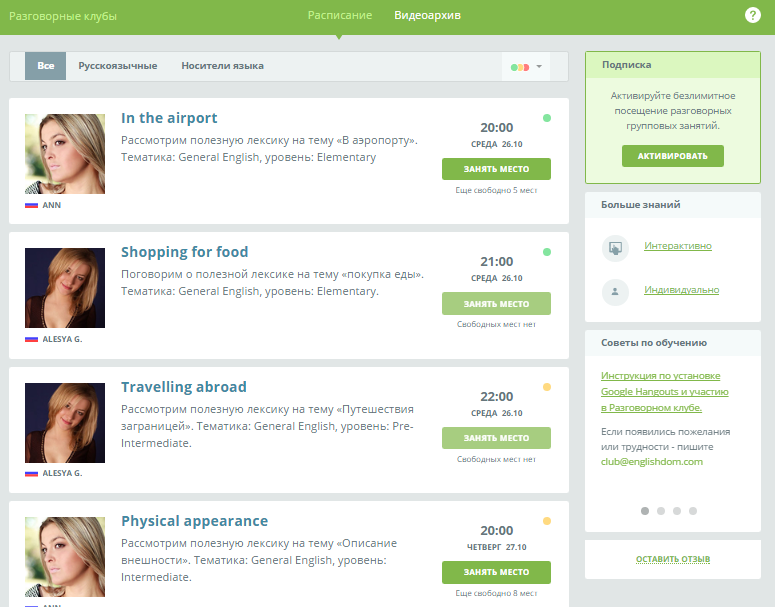
Test
Final stage - Test. Here, our system itself provides various types of lesson tasks in order to consolidate the knowledge gained.
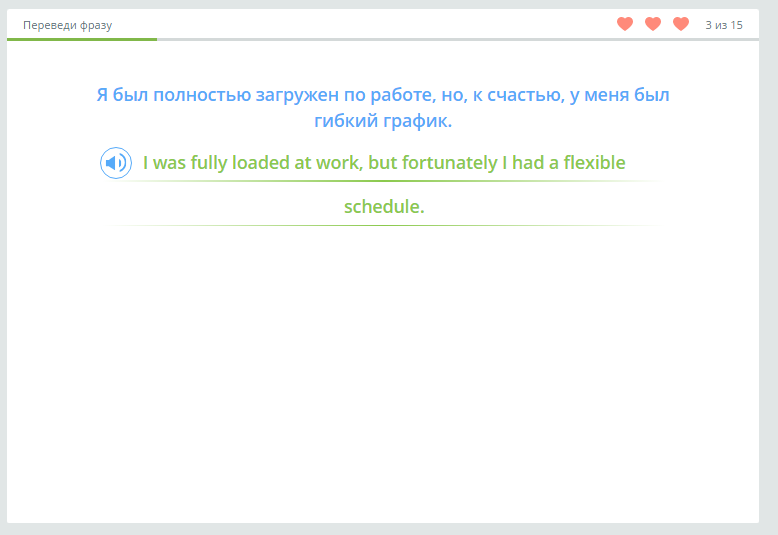
At this stage, you can make only two mistakes, otherwise it is better to take the course again, well, or at least a test;)
Well, that's all! Thank you very much for reading the description of our course and instructions for it to the end. And we really hope that our course will be to your taste and will help to tighten English.
EnglishDom teachers analyzed online courses on the market and found two main approaches to learning: an interactive textbook or cramming. Since both options do not imply diversity, then, accordingly, the results will be far from expected. Therefore, we tried to create a completely new product for the market and simulate a full-fledged lesson during which a student will be able to get all the necessary knowledge and consolidate the acquired skills without a teacher.
This is the first “release" of the product of our school. In the future, we plan to refine and improve the course, come up with new training opportunities and select materials of different levels. So now we need an honest feedback about the course, content, design and gamification. We ask you to register, test your knowledge and learn English thanks to our course. And after completing the course, send us your feedback on all stages.
We give you one-year access to the Online Course English course. To gain access, simply follow the link and after applying the promotional code, go through the registration by clicking on the link .
So that you can quickly understand the structure of the proposed course, we offer you a small instruction that will allow you to engage in training more effectively.
In developing our course, we first of all tried to solve the main problem of online services - a quick loss of interest in learning and, as a result, a decrease in student motivation (according to our surveys of online school students, after 3-4 months, the student quits classes).
Briefly about the course:
● the system provides the following difficulty levels: English for beginners (Elementary), conversational (Pre-Intermediate), intermediate level (Intermediate) + Upper-Intermediate (above average).
● Each level consists of 25 lessons: 25 topics in grammar + topics in vocabulary in conjunction with subsequent complication;
● The basic principle is structure, practice and consolidation. The student assimilates the material in different contexts, repeating it several times, eventually bringing the acquired skills to automatism. As practice shows, it is this approach that allows you to achieve better results, while not worse than in class with a real teacher.
We begin the dive! You are already waiting for the first lesson with a list of tasks.

Dictionary
Let's look at a dictionary that offers a list of thematic words for study.

The content is selected in such a way that the words given at the beginning of the lesson are repeated throughout the lesson and used later in other topics. Each word is accompanied by translation, transcription and image - all this helps to highlight the speech structure in memory, linking it with the desired association.
The “Train” button opens a page with a new task: you need to spell a word, select or enter the correct translation. Each correct answer increases the level of progress, while the learned words will not disappear: you will repeat them in the next steps, and so on until you are fully included in the active vocabulary.
Theory
Theory is a grammatical part that allows you to understand the database and fill in the existing gaps. The concept of the material is strictly structured and dosed, and the flow is maximally simplified and accessible so as not to get confused in unnecessary terminology. This allows the student, not overloaded with information, to gain real knowledge, and not a headache.
During each lesson, students must learn a small and understandable rule. The text is accompanied by examples and supplemented by a video explaining the real teacher.

Practice
After the theory we pass to Practice! Grammar and vocabulary exercises from the lesson. There are three types - enter the missing words, choose the correct option and translate the sentence using special blanks. These types of tasks help to memorize grammar, as well as repeat written speech and make better use of individual meanings of words. All exercises are supplemented by audio tracks so that you hear the correct pronunciation of words and memorize them.

After passing, you will see your results in the form of progress, having received experience points, and proposals in which mistakes were made can be re-executed.

Life-story
One of the ways to replace the routine work with text is the Life story section. We tried to simulate up to five different workouts, allowing you to immerse yourself in the maximum language environment, and not boredom. All material is taken from various sources - popular films and series, interesting books, modern songs - and touches on a variety of life situations from simple and ordinary to the most incredible and distant from the usual “London is the capital of Great Britain”.
Teachers carefully worked out the content, highlighting grammatical constructions and phrases for memorizing, which are learned in exercises after the text. The list of tasks is quite varied - to fill in the blanks, put the events in the correct sequence or guess how truthfully in relation to the video or text several suggestions are made. As a result, all the material is interesting to read and easy to remember. No boring textbooks!

Phrasebook
To memorize phrases and sentences effectively, you will need a special tool - Phrasebook. Any skill needs to be fixed with persistent training. To ensure that students are not bored of repeating speech constructions, we use elements of the game during the lesson, which allows students to practice various exercises on their own. Our experience with students shows that sustainable knowledge and the ability to put into practice a particular rule comes after 7-9 repetitions. And if these exercises are as diverse as possible, this will help not to lose interest in learning.
To ensure that the speech is correct and figuratively rich, students are encouraged to practice pronunciation of popular idioms, as well as standard questions and answers to them. And all this is fixed with the help of exercises on choosing an option, filling in the gaps or translating in parts.

Dialogue
Dialogue is associated with the development of a conversational skill. Since the course was written by current teachers, it contains their best case studies on "live" lessons. We took the most real and useful situations, as well as the dialogs that students liked, and beat them. Students are invited to participate in the survey (interviewer is a robot), however with existing answers (they are generated as part of the topics being studied). You need to pronounce them correctly into the microphone or (if it is not) manually select the correct answer.

Conversation lesson
If you want to make sure in practice that the classes were not in vain and the material is learned, we give you the opportunity to use our Conversation Club on your topic. Talk with other students, native speakers and educators to improve your communication skills and diversify your vocabulary on the topic in a webinar format. In the training course, this step is not mandatory, but we give students the opportunity to familiarize themselves with the list of questions for the lesson in order to be more prepared.
For the convenience of students, there is a schedule in the course, the ability to prepare and sign up for a suitable time. You can even choose a moderator - a Russian-speaking teacher or an English-speaking one.

Test
Final stage - Test. Here, our system itself provides various types of lesson tasks in order to consolidate the knowledge gained.

At this stage, you can make only two mistakes, otherwise it is better to take the course again, well, or at least a test;)
Well, that's all! Thank you very much for reading the description of our course and instructions for it to the end. And we really hope that our course will be to your taste and will help to tighten English.
